Sustainable Restoration: Engineers Look to Stabilize and Revitalize Historic North Carolina Farm
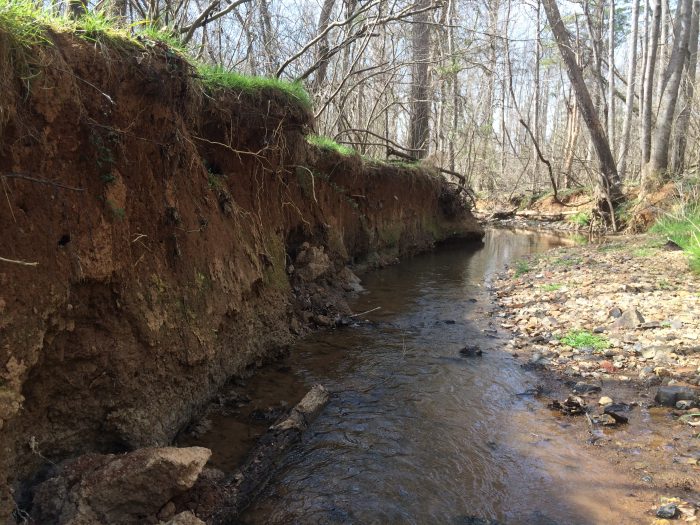
By Scott King, Project Manager
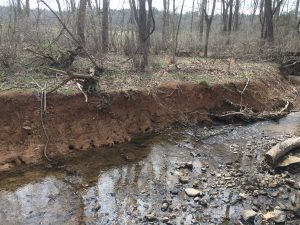
Vertical, unstable, eroding stream banks will be cut back and vegetated for stabilization.
The historic Lochill Farm, nestled in the rolling hills of the Piedmont in the heart of North Carolina, has been a regional treasure for more than 200 years. Located just outside the town of Hillsborough, N.C., in the Upper Neuse River basin, the farm offers a unique landscape along Finches Branch stream and its tributaries, where horseback riders can enjoy leisurely strolls through nature.
Dating back to its opening in the 18th century, Lochill Farm has been employed for a variety of uses beyond its deep-seeded roots as a working horse farm, as the fertile lands of the basin have proven ripe for agricultural applications—ranging from row crops to pastures for livestock.
Although the watershed is currently heavily forested with secondary growth, previous logging activities removed much of the original tree coverage. It’s these activities, coupled with the development of a nearby residential community, that have negatively impacted the existing stream reach, floodplains and wetlands on the property, which ultimately threaten the farm’s viable future.
In fact, these impacts have caused the streams to straighten, becoming incised and disconnected from historic floodplains. Approximately 45 percent of the stream banks proposed for restoration or enhancement are steep and highly eroded along the entire length of the main stem and have narrow (less than 20-feet-wide) riparian buffers—vegetated areas near the stream that provide shade and protection. The stream incision also robs the wetlands of the hydrology needed for proper functioning.
Restorative Promise
The North Carolina Department of Environmental Quality recognized the need for stream restoration, as continued unchecked negative activities could potentially leave not only Finches Branch stream, but the entire watershed, in a state of disrepair.
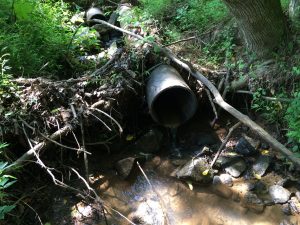
Clogged and scoured pipe crossings result in stream disconnects, preventing the free movement of aquatic organisms.
To restore and improve the water quality and wildlife habitat of the stream and surrounding landscape, a design solution addresses the property’s perennial and intermittent stream reaches. The design includes restoring riparian buffers along all the project stream reaches currently in pasture, improving degraded wetlands and reducing the number of stream crossings to provide the maximum functional uplift. The remaining stream crossing will be improved through installation of correctly sized pipe culvert crossings. Currently, several old pipe crossings have clogged and scoured, causing a stream disconnect. This prevents the free and open passage of aquatic organisms and causes sediment to build up in the upstream section. The new crossings will restore proper functioning.
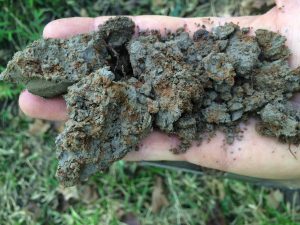
Gray, mottled, hydric soil is indicative of riparian wetlands.
Streambeds also will be raised to their proper elevations, reconnecting the stream to its original floodplain. By doing this, proper hydrology and the full functional value to the adjacent wetlands will be restored. The design is intended to increase the sinuosity of the stream to its natural pattern, increasing its overall length and providing long-term stability through increased energy dissipation.
This, in turn, will restore Finches Branch and its two main tributaries while preserving an additional five spring-fed tributaries, totaling approximately 5,500 linear feet of existing streams that are part of the Lochill Farm drainage area. In-stream features also were considered as part of the design, including riffles and pools, physical structures such as log weirs and vanes, root wads, geo-lifts with brush toe, rock step pools, rock J-hooks, and grade-control log jams.
The design also calls for the complete stabilization of all the eroding banks. The team will grade back gentler side slopes as well as plant fast-growing live-stake vegetation such as willows, silky dogwoods and alders. The old channel will be filled in and blocked with clay plugs, but it will incorporate periodic depressional areas to create shallow ephemeral ponds, which provide habitat for a range of organisms, most notably amphibians. These design elements were chosen because they best mimic the natural conditions found in more pristine stream reaches of a similar size found in similar parts of the North Carolina Piedmont.
Looking to the Future
As the project continues, further wetland rehabilitation will be achieved through re-establishing a native riparian wetland vegetation community, removing limited upland soils and permanently excluding livestock to protect soil structure and vegetation. By eliminating access points, livestock will be permanently excluded from all areas of the project, with buffers in excess of 50 feet established along all proposed reaches. Native hardwood trees and shrub species will be planted along the entire riparian buffer to promote native wildlife along the newly vegetated stream corridor. All work will be protected by a perpetual conservation easement.
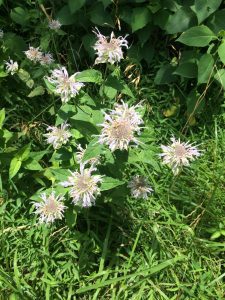
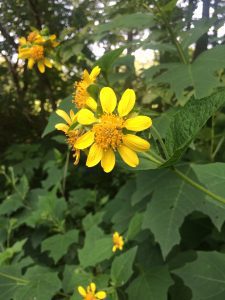
In addition, a thorough baseline and existing-conditions assessment will be used to develop mitigation plans that will include post-construction monitoring efforts to confirm project success. These studies include field evaluations of unstable banks, photographic documentation, cross-sectional surveys, streambed substrate analysis, hydric soils/wetlands evaluations and a full survey of pertinent site features.
The native Mondard fistulosa (bee balm, left) and Smallanthus uvedalia (bearsfoot flower, right) are commonly found onsite.
Expanding Reach Beyond the Farm
Although many of these design benefits are limited to the Lochill Farm/Finches Branch stream project area, other activities such as nutrient removal, sediment reduction and improved aquatic and terrestrial habitat have more far-reaching impacts, potentially extending downstream to the nearby Eno River.
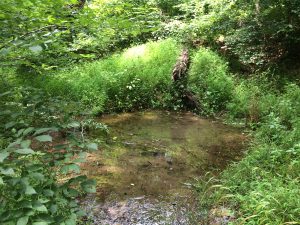
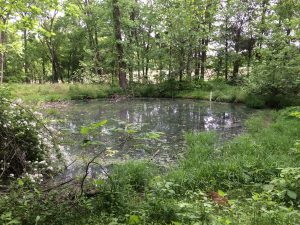
Sediment is the No. 1 pollutant in North Carolina; it buries valuable stream habitats, harms drinking-water supplies, and decreases the aesthetic and recreational value of downstream waters. The direct improvement of water quality will be enhanced with the restoration of the adjacent wetland areas and through creation of a permanent forested corridor along the streams. To achieve improved water quality, several actions will be undertaken to remove nutrients. This will be achieved by removing animals from the stream, restoring a full riparian buffer capable of filtering nutrients from groundwater and runoff, and stabilizing eroding banks—sediment often contains high levels of nutrients attached to soil particles.
As the project breaks ground in late 2017, physical improvements will be visible in short order. The design and efforts will help extend the life of a two-century-old gem as well as give future generations the opportunity to enjoy the beauty of Lochill Farm.
However, beyond what’s visible to the naked eye, the project’s ultimate success will not be felt for more than seven years, as site stability must be closely monitored. In these unseen actions, true lasting impact can be achieved, as streams and wetlands ultimately create life and vibrancy across the extended region.
About Scott King
Scott King is the project manager and an Environmental Specialist in Michael Baker International’s Ecosystem Restoration Group within the Water Resources Practice located in Cary, Asheville and Charlotte, N.C.; e-mail: [email protected].


